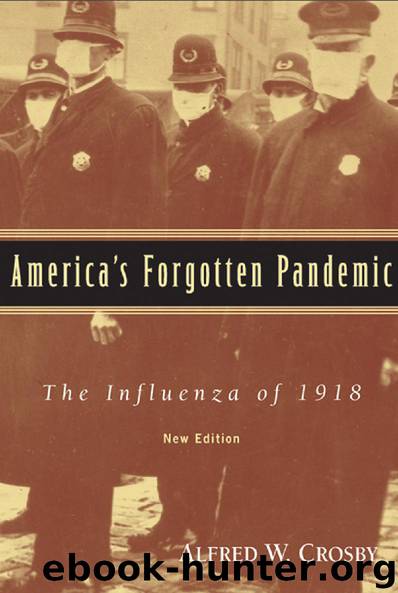America's Forgotten Pandemic by Alfred W. Crosby

Author:Alfred W. Crosby [Crosby, Alfred W.]
Language: eng
Format: epub
Publisher: Cambridge University Press
Published: 0101-01-01T00:00:00+00:00
Great Britain, Ministry of Health, Reports on Public Health and Medical Subjects Number 4, Report on the Pandemic of Influenza, 1918–19 (London: His Majesty’s Stationery Office, 1920), p. 228.
The rise in the number of flu and pneumonia deaths, which as always lagged a week or so behind the rise in new cases, did not appear in the death rolls of Paris until the week ending February 8; in that week flu deaths jumped 18 and pneumonia deaths 73 over the previous week’s record. The winter wave crested in Paris in the week ending February 22 and thereafter fell off slowly for the rest of the winter and spring. In January 1,488 died of flu and pneumonia; in February 2,676; and in March 1,517.34
The winter wave largely escaped attention because of the peace conference. Charles Seymour, House’s protégé and future president of Yale, did not permit even Spanish influenza to distract him. He blamed his “cold” on the weather and complained in mid-February that
everyone has a cold here, and the Paris cold seems to take it out of one more than any I have known. I am all right now and quite chipper, but yesterday I felt as shaky as if I had had typhoid.35
Flu abruptly struck down James T. Shotwell, Columbia University historian and also an American aide, when he was dining with some Yugoslavs. Norman Davis, the American financier and diplomat, came down with pneumonia. David Hunter Miller, House’s chief legal adviser, encountered a major distraction from his work when his wife caught not simply flu but pneumonia. On the peak day of this wave of flu in the American delegation, its doctors made 125 sick calls.36
Other nationalities than American suffered during flu’s winter resurgence in Paris, but there were few deaths to interfere with the processes of diplomacy. One may wonder, however, if the total accretion of fatigue and malaise, the aftermath of nearly every attack of influenza, didn’t play some immeasurable but significant role in gumming up those processes. Harold Nicolson, who also had a case of flu or a bad cold, acted on occasion in ways that smack of the effect that the devil grippe can have on the human body and mind. He complained of being very tired and that “the strain is appalling.” He committed the diplomat’s most heinous sin, losing his temper at a committee meeting with foreigners and startling everyone. In March he described himself as
dispirited, saddened and one mass of nerves jangled and torn . . . even the pebbles on the pavements assume for me the shapes of frontiers, salients, corridors, neutralized channels, demilitarized zones, islands, ‘bees de carnard.’37
As the stock Irishman of the music halls of the era put it, “the grippe is a sickness you don’t get over until a month after you’ve done with it.”
But not even a full-scale return of the fall wave could have distracted attention from the goings and comings of the mighty. On February 14 Wilson, having persuaded the European powers to accept
Download
This site does not store any files on its server. We only index and link to content provided by other sites. Please contact the content providers to delete copyright contents if any and email us, we'll remove relevant links or contents immediately.
Periodization Training for Sports by Tudor Bompa(8211)
Why We Sleep: Unlocking the Power of Sleep and Dreams by Matthew Walker(6655)
Paper Towns by Green John(5138)
The Immortal Life of Henrietta Lacks by Rebecca Skloot(4550)
The Sports Rules Book by Human Kinetics(4343)
Dynamic Alignment Through Imagery by Eric Franklin(4176)
ACSM's Complete Guide to Fitness & Health by ACSM(4019)
Kaplan MCAT Organic Chemistry Review: Created for MCAT 2015 (Kaplan Test Prep) by Kaplan(3970)
Introduction to Kinesiology by Shirl J. Hoffman(3743)
Livewired by David Eagleman(3729)
The Death of the Heart by Elizabeth Bowen(3579)
The River of Consciousness by Oliver Sacks(3572)
Alchemy and Alchemists by C. J. S. Thompson(3481)
Bad Pharma by Ben Goldacre(3396)
Descartes' Error by Antonio Damasio(3248)
The Emperor of All Maladies: A Biography of Cancer by Siddhartha Mukherjee(3112)
The Gene: An Intimate History by Siddhartha Mukherjee(3074)
The Fate of Rome: Climate, Disease, and the End of an Empire (The Princeton History of the Ancient World) by Kyle Harper(3033)
Kaplan MCAT Behavioral Sciences Review: Created for MCAT 2015 (Kaplan Test Prep) by Kaplan(2957)
